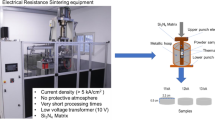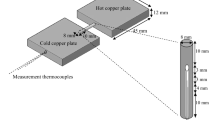Abstract
Eutectic alloys of Sn with Cu, Cd, Al, Pb and Sb (peritectic) were produced by the melt-spinning technique. These alloying elements were chosen according to their valencies +1, +2, +3, +4 and +5 respectively. X-ray diffraction analysis (XRD) was carried out. Young’s modulus and resistivity were measured. It was found that, alloying Sn with low valency metals such as Cu and Cd increases the axial ratio and alloying Sn with high valency metals such as Pb, Sb and Bi decreases the axial ratio. Also Young’s modulus was found to increase by increasing the axial ratio and decreases by decreasing it. On the contrary the resistivity decreases by increasing the axial ratio.
Similar content being viewed by others
References
M. Kamal, A. B. EL-Bediwi and T. E-Ashram, J. Mater. Sci. Mater. Electr. 15 (2004) 211.
G. V. Raynor and J. A. Lee, Acta Met. 2 (1954) 616.
R. H. Kane, B. C. Giessen and N. J. Grant, Acta Met. 14 (1966) 605.
C. J. Smithells and E. A. Brandes, in “Metals Reference Book”, 5 ed. (Butterworth and Co.(Publishers) Ltd., U.K., 1976), p. 940.
J. C. Anderson, K. D. Leaver, R. D. Rawlings and J. M. Alexander, in “Materials Science”, 3 ed. (Van Nostrand Reinhold (UK) Co. Ltd. 1985), p. 248&504.
W. Hayden, W. G. Moffat and J. Wulff, in “Mechanical Behavior”, 3 ed. (Wiley Eastern private limited, New Delhi, 1974) p. 36.
Y. A. Geller and A. G. Rakhshtadt, “Science of Materials”, (Mir Publishers, Moscow, 1977) p. 138.
E. Schreiber, O. L. Anderson and N. Soga, in “Elastic Constants, and their Measurements” (McGraw Hill book Company, 1973) p. 82.
Selected Powder Diffraction Data for Education & Training, Search Manual and Data Cards, JCPDS, International Center For Diffraction Data, Editor-in-Chief, William Frank McClune, 1601 Park Lan, Swarthmore, PA 19081–2389, JCPDS, 1988 printed in U.S.A.
K. Schubert, U. Roseler, W. Mahler, E. Doerre and W. Schuett, Z. Metallk 45 (1954) 643.
D. R. Frear, S. N. Burchett, H. S. Morgan and J. H. Lau, (eds.), “The Mechanics of Solder Alloy Interconnects”, (Van Nostrand Reinhold, New York, 1994) p. 60.
A. H. Cottrell, in “Theoretical Structure Metallurgy” (The Camelt press Ltd. 1964) p. 77.
Author information
Authors and Affiliations
Corresponding author
Rights and permissions
About this article
Cite this article
El-ASHRAM, T. The relation between valency, axial ratio, Young’s modulus and resistivity of rapidly solidified tin-based eutectic alloys. J Mater Sci: Mater Electron 16, 501–505 (2005). https://doi.org/10.1007/s10854-005-2724-3
Received:
Accepted:
Issue Date:
DOI: https://doi.org/10.1007/s10854-005-2724-3




